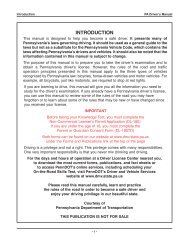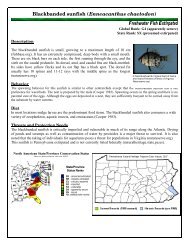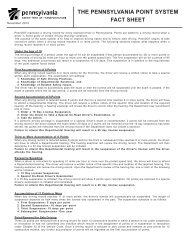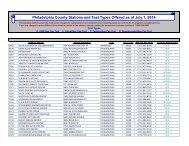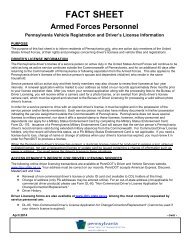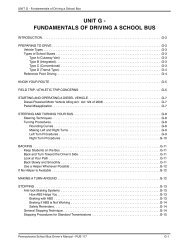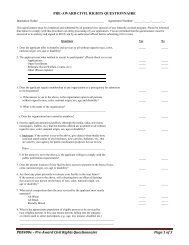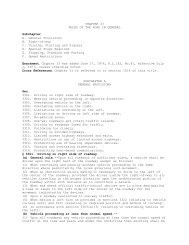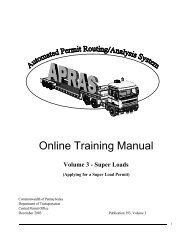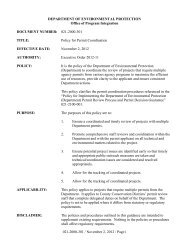PennDOT - Hazardous Materials Endorsement Renewal Manual
PennDOT - Hazardous Materials Endorsement Renewal Manual
PennDOT - Hazardous Materials Endorsement Renewal Manual
You also want an ePaper? Increase the reach of your titles
YUMPU automatically turns print PDFs into web optimized ePapers that Google loves.
and permits change often. It is your job as driver to find out if you need<br />
permits or must use special routes. Make sure you have all needed papers<br />
before starting.<br />
If you work for a carrier, ask your dispatcher about route restrictions or<br />
permits. If you are an independent trucker and are planning a new route,<br />
check with state agencies where you plan to travel. Some localities prohibit<br />
transportation of hazardous materials through tunnels, over bridges, or other<br />
roadways. Check before you start.<br />
Whenever placarded, avoid heavily populated areas, crowds, tunnels,<br />
narrow streets, and alleys. Take other routes, even if inconvenient, unless<br />
there is no other way. Never drive a placarded vehicle near open fires unless<br />
you can safely pass without stopping.<br />
If transporting Division 1.1, 1.2, or 1.3 (Class A or B) explosives, you must<br />
have a written route plan and follow that plan. Carriers prepare the route plan<br />
in advance and give the driver a copy. You may plan the route yourself if you<br />
pick up the explosives at a location other than your employer's terminal.<br />
Write out the plan in advance. Keep a copy of it with you while transporting<br />
the explosives. Deliver shipments of explosives only to authorized persons or<br />
leave them in locked rooms designed for explosives storage.<br />
a carrier must choose the safest route to transport placarded radioactive<br />
materials. after choosing the route, the carrier must tell the driver about the<br />
radioactive materials, and show the route plan.<br />
NO SMOKING<br />
Do not smoke within 25 feet (7.6m) of a placarded cargo tank used for Class<br />
3 (flammable liquids) or Division 2.1 (gases). also, do not smoke or carry a<br />
lighted cigarette, cigar, or pipe within 25 feet (7.6m) of any vehicle which<br />
contains:<br />
Class 1 Class 3<br />
EXPLOSIVES<br />
FLaMMaBLE LIQUIDS<br />
Class 4 Class 5<br />
FLaMMaBLE SOLIDS<br />
OXIDIzERS<br />
REFUEL WITH ENGINE OFF<br />
Turn off your engine before fueling a motor vehicle containing hazardous<br />
materials. Someone must always be at the nozzle, controlling fuel flow.<br />
10 B:C FIRE EXTINGUISHER<br />
The power unit of placarded vehicles must have a fire extinguisher with a UL<br />
rating of 10 B:C or more.<br />
- 28 -



